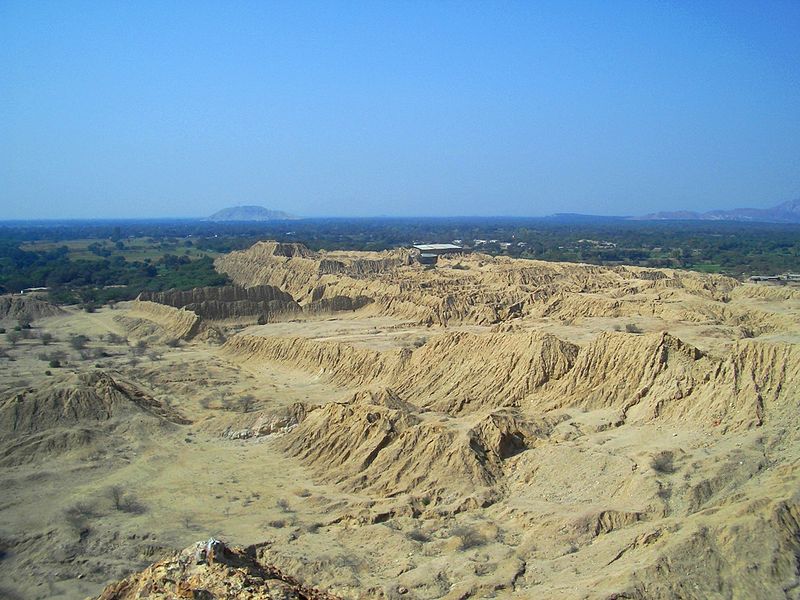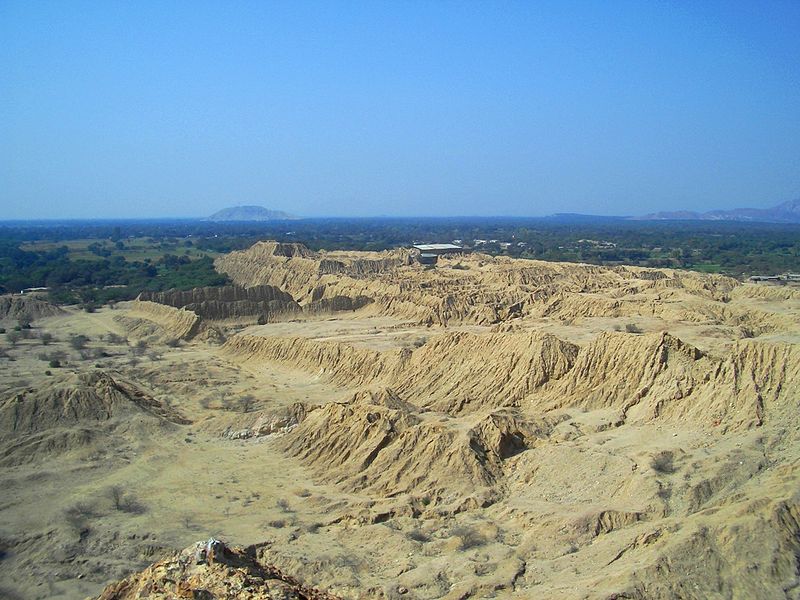The Origin of the Inca Gold at the Pyramid City of Túcume the site of the Lambayeque cultures where tons of gold were still found in the 20th century. Astrology, History and Magical Places: on the astrogeographical position of the pyramid city in Aries with Gemini
Related articles: Aquarius as the corresponding sign of Maya culture, Lake Guatavita the site of El Dorado in astrogeography, Skylodge Adventure Suites – luxury 1300 feet above the ground, The Gold Pyramid House Between Earth & Sky, Templo Mayor in Mexico City and the astrogeographic Position of Tenochtitlan, The Sacred City of Caral in the Supe Valley in Peru, Sechin Bajo – the oldest Building in America, The Sun Temple of Machu Picchu
The Origin of the Inca Gold at the Pyramid City of Túcume

photo: Euyasik, GNU/FDL
The more than 250 pyramids of Túcume in northern Peru were constructed between 1000-1350 by the so-called Lambayeque or Sican culture. After the decline of the Sican/Lambayeque culture which existed between 800 Ce and1350 CE the area was controlled by the Chimú (1350–1450 CE) and later the Inca (1450–1532 AD) people.
The pyramids were built of sun-dried mud brick. After 800 years of erosion they look like giant termite mounds today. Next to the pyramids a great number of grave chambers have been found that partially contained tons of gold. Local people call the place “Purgatorio” (Purgatory). Local shamans (curanderos) are said to invoke the power of Tucume and La Raya Mountain in their rituals, and local people fear these sites.

Most of the Inca gold had been mined and manufactured by the people of the Sican/Lambayeque Culture whose skills and crafts were by far superior to those of the Inca.
Astrogeographical resonance coordinates
Field level 2 (City)
Astrogeographic position for morphogenetic radius/field level 2 which describes the energetical qualities of the city and larger area in which the large pyramid field of Túcume is located : the pyramid field lies in the combination of highly dynamic, alert, male fire sign Aries sign of action, speed, fighting for survival, warfare and aggression with practical air sign Gemini the sign of intelligence, communication, technology, learning, information, road crossings and a typical indicator for the unhindered exploitation of natural resources. Gemini appears to be an important factor for the sites of pyramids
The combination of Gemini as the sign of technology with Aries the sign of aggression makes the purgatory of Túcume seem like an early historical example for the consequences of excessive proliferation of technological development.
Field Level 1 (global resonance)
Astrogeographic position of Tucume for morphogenetic field level 1 which describes the international, supraregional resonance and meaning of the Lambayeque culture: one coordinate lies on 0° Gemini the sign of technology resonating with the superior technology of the metal processing and goldsmith arts of the Lambayeque. This astrogeographic position has also a direct resonance through exact opposition with the astrogeographical position of Lake Guatavita the site of El Dorado in Columbia. Compare my article. The direct opposition between the site of the production of the Inca Gold and the symbolic site of the Gold Rush throws a fascinating light on the astrological interpretation of these two zodiac signs.
The 2nd resonance coordinate is 7° in earth sign Virgo the sign of hidden and protected places, optimal use of resources, harvest, storing goods and the most important astrological indicator for pyramids and of mummification and conservation. Compare: The Pyramids of Giza in Gemini with Virgo, Chichen Itza in Virgo with Aquarius, The Valley of the kings in Virgo with Aquarius.

